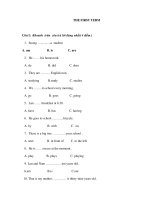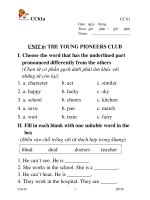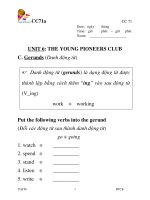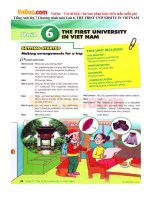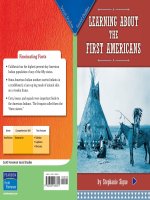5 6 the people who gave us the US constitution
Bạn đang xem bản rút gọn của tài liệu. Xem và tải ngay bản đầy đủ của tài liệu tại đây (2.92 MB, 10 trang )
Fascinating Facts
• At the Constitutional Convention, Benjamin
Franklin’s health was so poor that he had to be
carried to the sessions in a chair. Still, he rarely
missed a session.
• George Washington signed the Constitution but not
the Declaration of Independence. At the time the
declaration was signed, he was in New York serving
as the commander of the Continental Army.
• More than half of the delegates to the
Constitutional Convention were lawyers or had
studied law.
Genre
Nonfiction
Comprehension Skill
Draw Conclusions
Text Features
• Captions
• Headings
Scott Foresman Social Studies
ISBN 0-328-14894-6
ì<(sk$m)=beijed< +^-Ä-U-Ä-U
In 1787 some of the smartest people in the
nation met at the Constitutional Convention.
These people had many different ideas about
how the country should be run. Luckily, they
also knew how to cooperate. In this book
you will learn about some of the people who
wrote our Constitution.
Vocabulary
delegate
compromise
Write to It!
The Constitution was a plan for an entire nation.
It was not easy to write, especially because the
delegates did not agree about everything. Write
one paragraph in which you explain what you
admire most about the people who wrote our
Constitution. Be sure to include examples to
support your opinion.
Write your opinion on a separate sheet of paper.
legislative branch
executive branch
judicial branch
checks and balances
ratify
Photographs
Every effort has been made to secure permission and provide appropriate credit for photographic material. The publisher deeply
regrets any omission and pledges to correct errors called to its attention in subsequent editions.
Unless otherwise acknowledged, all photographs are the property of Scott Foresman, a division of Pearson Education.
Photo locators denoted as follows: Top (T), Center (C), Bottom (B), Left (L), Right (R), Background (Bkgd)
ISBN: 0-328-14894-6
Copyright © Pearson Education, Inc.
All Rights Reserved. Printed in the United States of America. This publication is protected
by Copyright, and permission should be obtained from the publisher prior to any prohibited
reproduction, storage in a retrieval system, or transmission in any form by any means,
electronic, mechanical, photocopying, recording, or likewise. For information regarding
permission(s), write to: Permissions Department, Scott Foresman, 1900 East Lake Avenue,
Glenview, Illinois 60025.
1 2 3 4 5 6 7 8 9 10 V0G1 14 13 12 11 10 09 08 07 06 05
Opener: ©The Granger Collection, NY
2 ©The Granger Collection, NY
4 ©The Granger Collection, NY
5 ©The Granger Collection, NY
6 ©The Granger Collection, NY
7 ©Library of Congress
8 ©The Granger Collection, NY
9 ©The Corcoran Gallery Editorial
of Art/Corbis
Offices: Glenview, Illinois • Parsippany, New Jersey • New York, New York
10 ©The Granger Collection, NY
11 ©The Granger Collection,
NY Offices: Needham, Massachusetts • Duluth, Georgia • Glenview, Illinois
Sales
12 ©The Granger Collection,
NY
Coppell,
Texas • Sacramento, California • Mesa, Arizona
13 ©The Granger Collection, NY
14 ©The Granger Collection, NY
In 1787 the early
leaders of our nation
wrote the Constitution.
The Constitution Is Written
When the American Revolution ended, the United States
had won its independence from Great Britain. The young
nation still faced many challenges.
The Articles of Confederation were the law in the United
States. The Articles set up Congress as the only branch.
The powers of Congress were very limited. For example,
Congress could not tax the people. This meant that
Congress did not have enough money to run the country.
2
In 1787 delegates met at the Constitutional
Convention in Philadelphia. The delegates did not all
agree about how to solve the problems of government.
However, after many debates and compromises, they
wrote the United States Constitution.
The Constitution set up a strong government with three
branches: the legislative branch, the executive
branch, and the judicial branch. It created a system
of checks and balances so that no single branch of the
government would become too powerful.
Who were the people who worked together to bring us
the Constitution? Read on to find out.
3
George Washington led the
Continental Army to victory in
the Revolutionary War.
In 1787 Washington believed that the country needed
a stronger government. The delegates all voted to make
Washington the leader of the Constitutional Convention.
They wanted a government that was strong but would still
protect the rights of the people. They wanted a government
that had the same qualities George Washington had.
As the leader of the Constitutional Convention,
Washington helped the delegates make
compromises.
George Washington
The delegates to the Constitutional Convention were
lawyers, soldiers, farmers, businesspeople, and
merchants. More than half of them had fought in the
Revolutionary War. Many of them had helped to write
their own states’ constitutions. One person, however,
stood out as the leader: George Washington of Virginia.
The entire country admired Washington. He had led the
Americans to victory. Washington was the young nation’s
greatest hero.
Washington did not want power. He wanted what was
best for the people. Washington wanted to work for the
good of the country.
4
George Washington
was the leader of
the Constitutional
Convention.
5
James Madison
Virginia delegate James Madison came to the
convention with a special plan for the nation. It was
called the Virginia Plan.
Under the Articles of Confederation, Congress was
made up of only one part. The Virginia Plan suggested a
Congress made up of two parts.
James Madison is called
“The Father of the Constitution.”
The final draft of the
Constitution included
many of the ideas from
the Virginia Plan.
Madison wanted three branches of government. He did
not want any of the branches to be too strong.
The delegates did not like everything in Madison’s
plan, but they agreed that the nation should have a strong
government with three balanced branches.
Madison spoke often at the convention. He helped with
the wording of the Constitution and took notes on the
debates.
7
Benjamin Franklin
Pennsylvania delegate Benjamin Franklin was called
the “Sage of the Constitutional Convention.” A sage is a
wise person who is honored for his or her experience and
judgment.
At the age of eighty-one, Franklin was the oldest
delegate to the convention. He had been a writer, a
scientist, an inventor, and a political leader.
The delegates respected Franklin. There were many
arguments and disagreements at the Constitutional
Convention, but Franklin helped the delegates
compromise.
Like Washington
and Madison, Franklin
believed that the nation
needed a strong national
government. He was not
happy with everything in
the final Constitution, but
he signed it anyway.
Franklin asked the other
delegates who were not
happy with the Constitution
to sign. He thought that the
nation had a better chance
Benjamin Franklin understood the
if everyone worked together. value of compromise.
Many of the delegates saw
the wisdom of this and signed.
Benjamin Franklin invented
many things, including the
lightning rod, the Franklin
stove, and bifocal glasses.
9
Alexander Hamilton
Alexander Hamilton, a delegate from New York,
believed that the nation needed a very strong
government. He wanted the President and senators
to serve for life terms. He also thought that state
governments were not necessary and that all power
should be held by the central government.
Most of the delegates disagreed with Hamilton. The
government that Hamilton wanted was too much like the
British government.
Alexander Hamilton wanted a
strong central government.
10
Hamilton was not totally happy with the Constitution.
He was afraid that the new government would be too
weak. Hamilton, however, put his own opinions aside and
signed the Constitution.
Hamilton did everything he could to support the
Constitution. He wrote essays explaining the benefits of
the new government. He asked the states to ratify the
Constitution. Because he was brave enough to put his
own opinions aside, Hamilton helped the Constitution to
become law.
Alexander Hamilton,
James Madison,
and John Jay wrote
essays in support of
the Constitution. This
collection of essays
was called The
Federalist.
Other Important Voices
Not every delegate wanted a strong government.
George Mason of Virginia, for example, wanted the
national government to stay weak. He worried that the
President would become like a king. He thought that a
strong government would take away the freedom of the
states and the people.
Thomas Jefferson believed in a strong government, but
like Mason, Jefferson thought that the Constitution needed
a bill of rights to protect the rights of the people. Jefferson
was not at the Constitutional Convention but he made sure
that his opinions were known.
George Mason refused to sign
the Constitution.
Thomas Jefferson thought the Constitution
needed a bill of rights.
Leaders realized that Congress would need to add a
bill of rights as soon as possible. The Bill of Rights that
became part of the Constitution would guarantee rights,
such as freedom of religion and freedom of speech.
13
The larger states felt that they should have more
representatives in Congress than the smaller states.
The smaller states thought that every state should have
the same number of representatives. Roger Sherman,
a delegate from Connecticut, came up with a solution
called the Great Compromise: the number of any state’s
representatives in the House of Representatives would
depend on the size of the state. Each state, however,
would have the same number of senators in the Senate.
The delegates decided that this compromise was fair.
The Constitution
was signed on
September 17, 1787.
For the Good of the Nation
Roger Sherman came up with
the Great Compromise.
On September 17, 1787, thirty-nine of the fifty-five
delegates to the Constitutional Convention signed the
Constitution. Few of the signers agreed with everything
that the Constitution said, but they did agree to work
together for the good of the nation.
The Constitution has guided our nation throughout our
nation’s history. We must thank the leaders who came
together in the spirit of strength, liberty, cooperation, and
compromise.
15
In 1787 some of the smartest people in the
Glossary
nation met at the Constitutional Convention.
checks
balances
a system
in which
Theseand
people
had many
different
ideas each
about
branch
of
government
checks
the
power
of
the
how the country should be run. Luckily, they
otherknew
branches
also
how to cooperate. In this book
you will learn
about
theside
people who
compromise
a deal
in some
whichof
each
wrote
oursomething
Constitution.
gives up
in order to reach
an agreement
delegate a representative
Vocabulary
executive branch the
part of the government that
delegate
is in charge of enforcing
our nation’s laws
compromise
Write to It!
The Constitution was a plan for an entire nation.
It was not easy to write, especially because the
delegates did not agree about everything. Write
one paragraph in which you explain what you
admire most about the people who wrote our
Constitution. Be sure to include examples to
support your opinion.
Write your opinion on a separate sheet of paper.
judicial branchlegislative
the part of branch
the government that is in
charge of interpreting our nation’s laws
executive branch
legislative branch the part of the government that
judicial branch
makes our nation’s laws
checks and balances
ratify to approve
ratify
Photographs
Every effort has been made to secure permission and provide appropriate credit for photographic material. The publisher deeply
regrets any omission and pledges to correct errors called to its attention in subsequent editions.
Unless otherwise acknowledged, all photographs are the property of Scott Foresman, a division of Pearson Education.
Photo locators denoted as follows: Top (T), Center (C), Bottom (B), Left (L), Right (R), Background (Bkgd)
ISBN: 0-328-14894-6
Copyright © Pearson Education, Inc.
All Rights Reserved. Printed in the United States of America. This publication is protected
by Copyright, and permission should be obtained from the publisher prior to any prohibited
reproduction, storage in a retrieval system, or transmission in any form by any means,
electronic, mechanical, photocopying, recording, or likewise. For information regarding
permission(s), write to: Permissions Department, Scott Foresman, 1900 East Lake Avenue,
Glenview, Illinois 60025.
16
1 2 3 4 5 6 7 8 9 10 V0G1 14 13 12 11 10 09 08 07 06 05
Opener: ©The Granger Collection, NY
2 ©The Granger Collection, NY
4 ©The Granger Collection, NY
5 ©The Granger Collection, NY
6 ©The Granger Collection, NY
7 ©Library of Congress
8 ©The Granger Collection, NY
9 ©The Corcoran Gallery of Art/Corbis
10 ©The Granger Collection, NY
11 ©The Granger Collection, NY
12 ©The Granger Collection, NY
13 ©The Granger Collection, NY
14 ©The Granger Collection, NY
